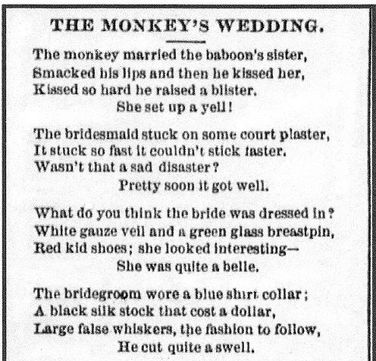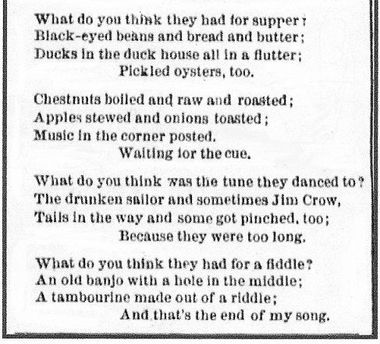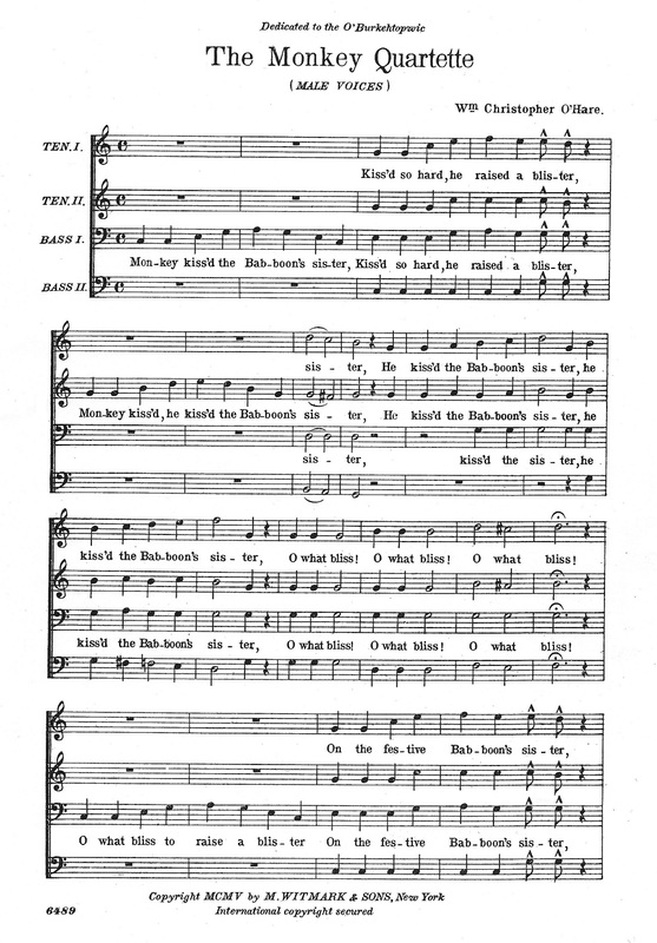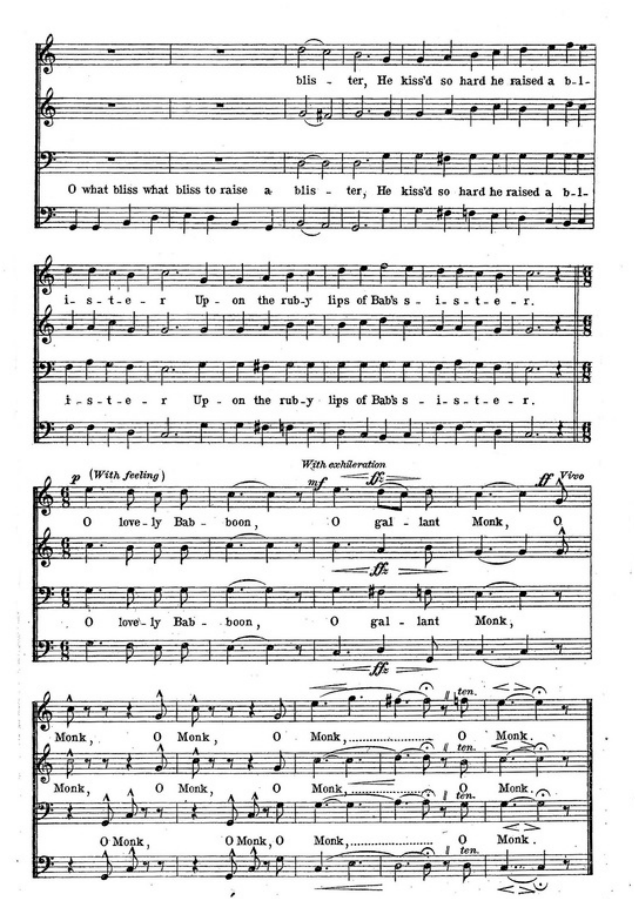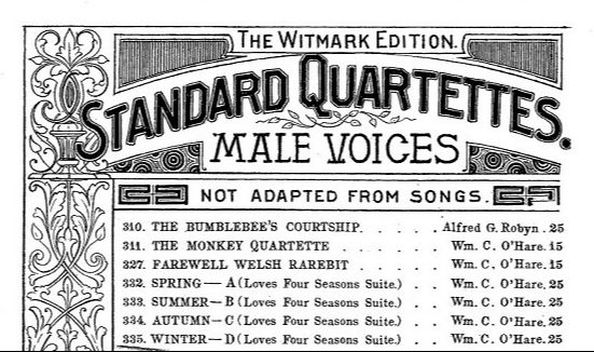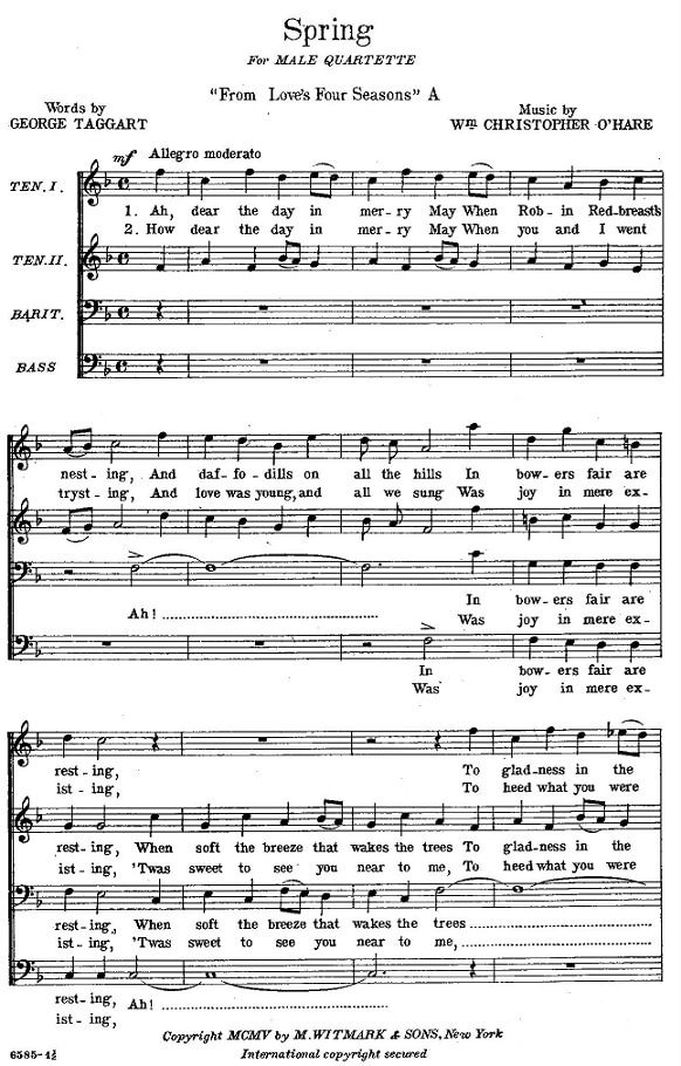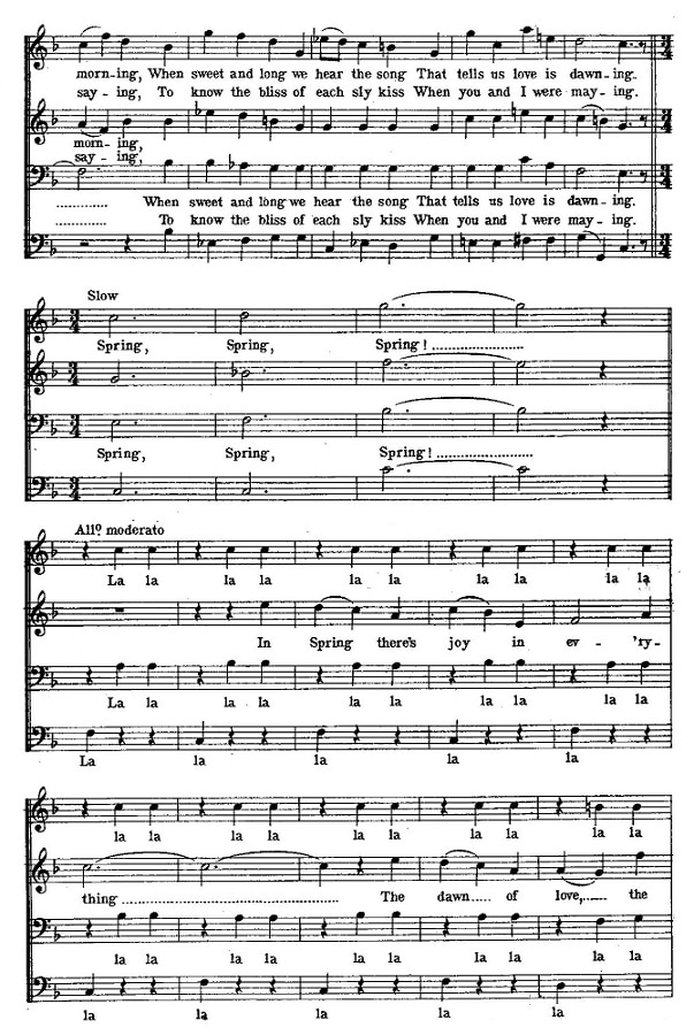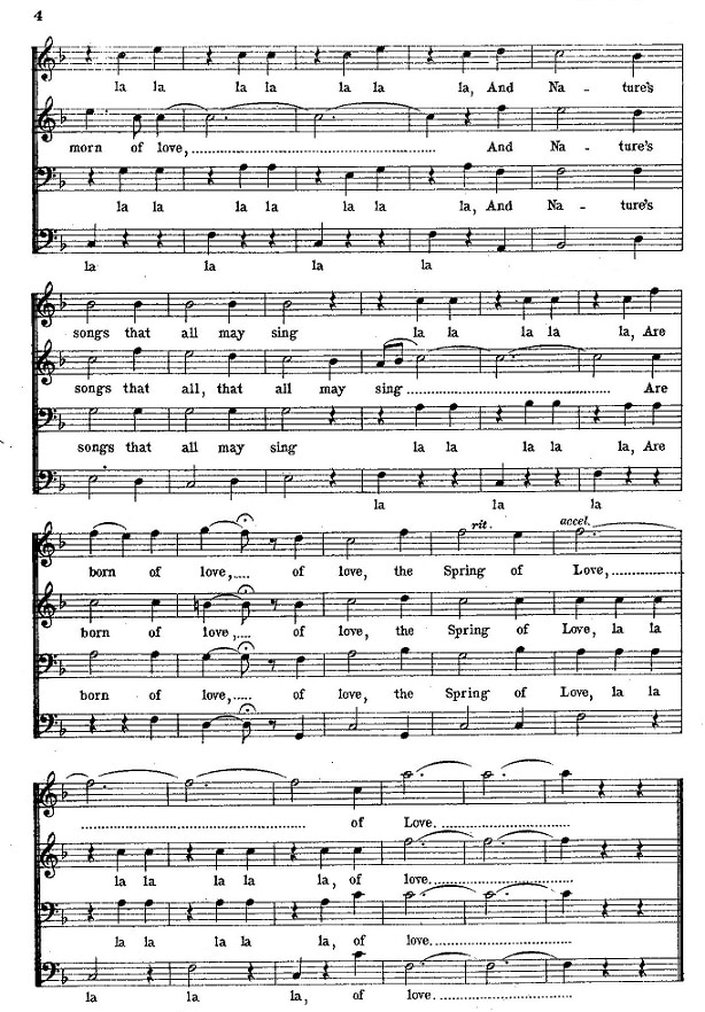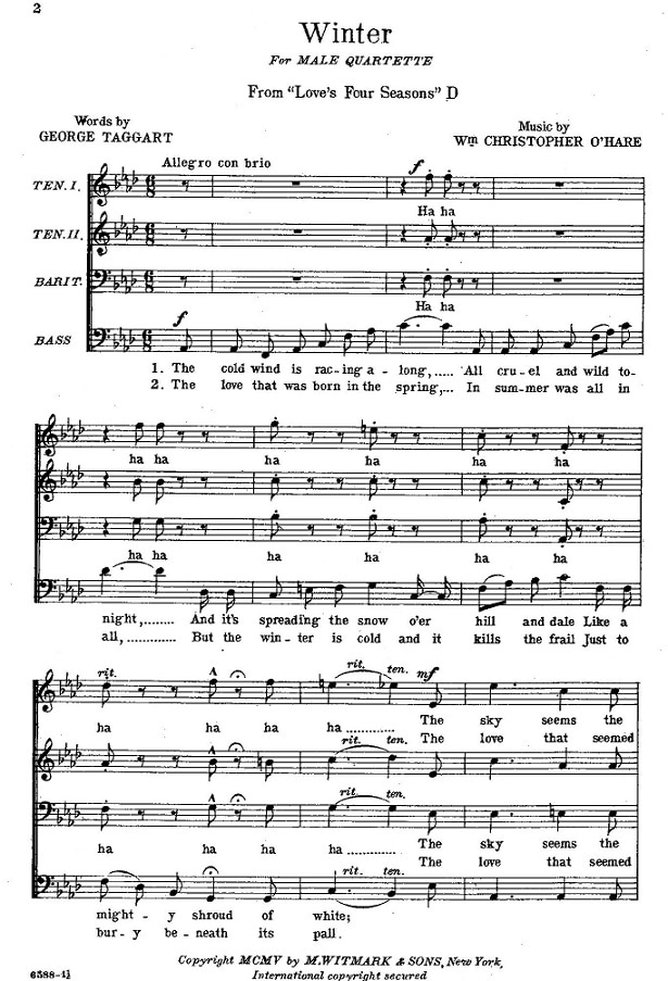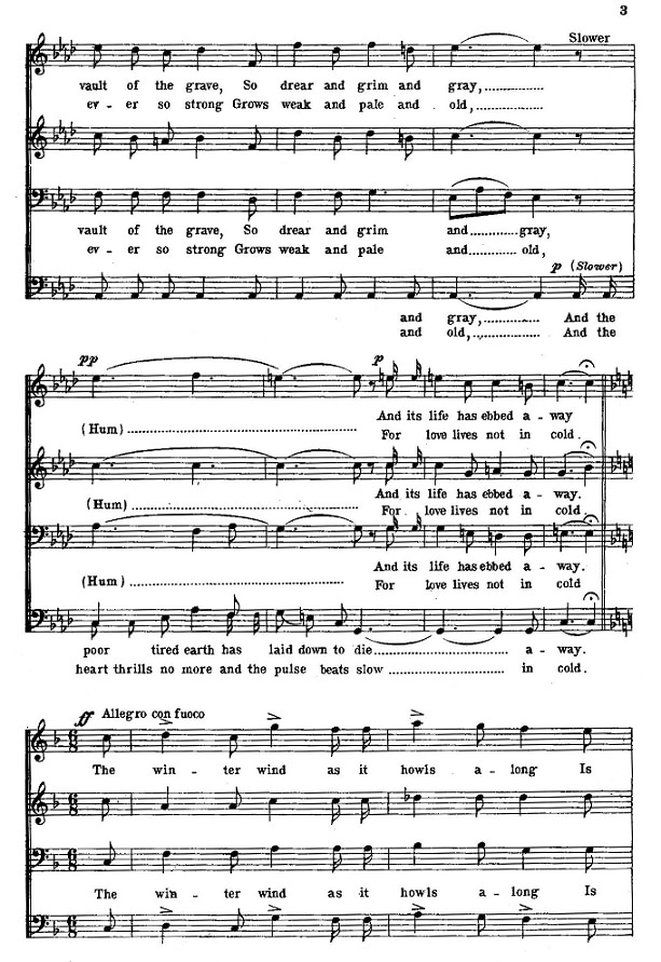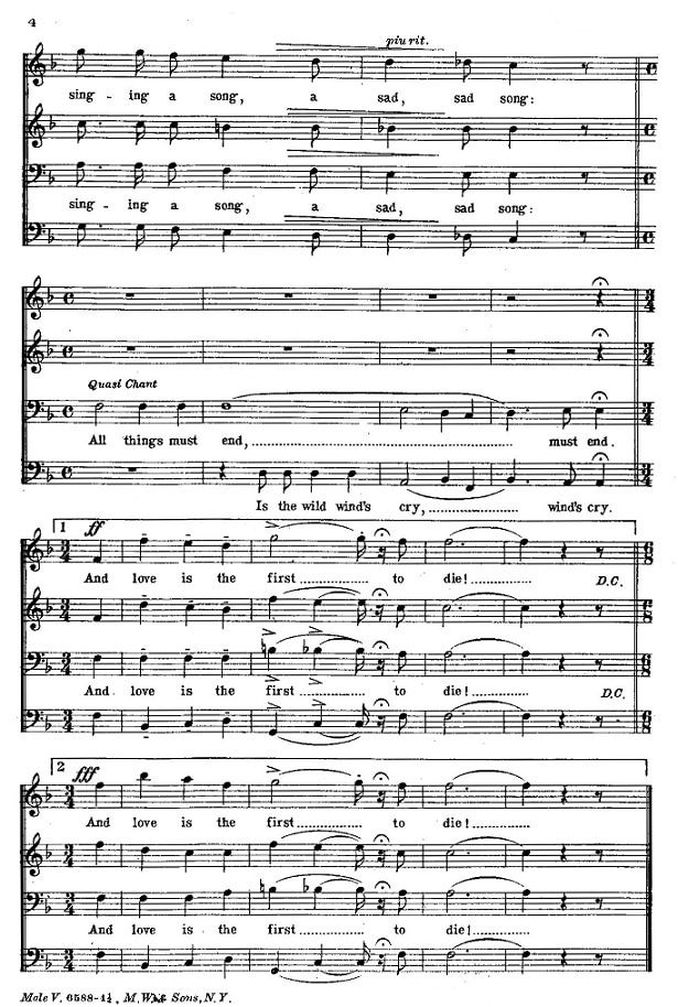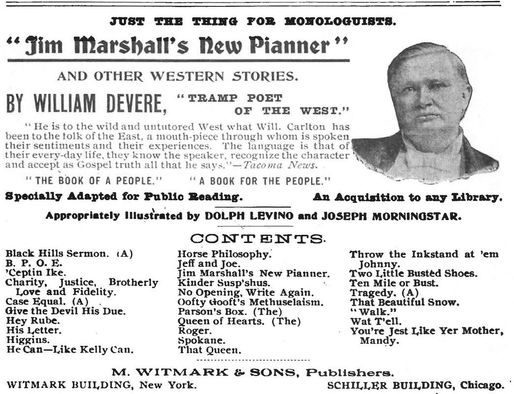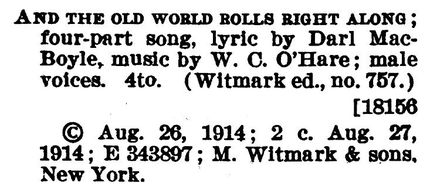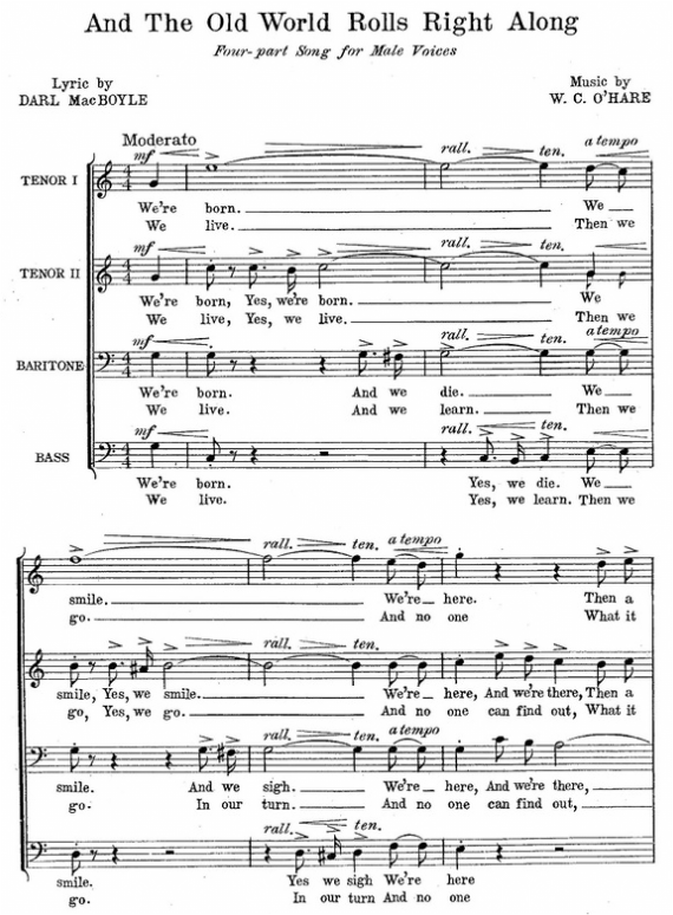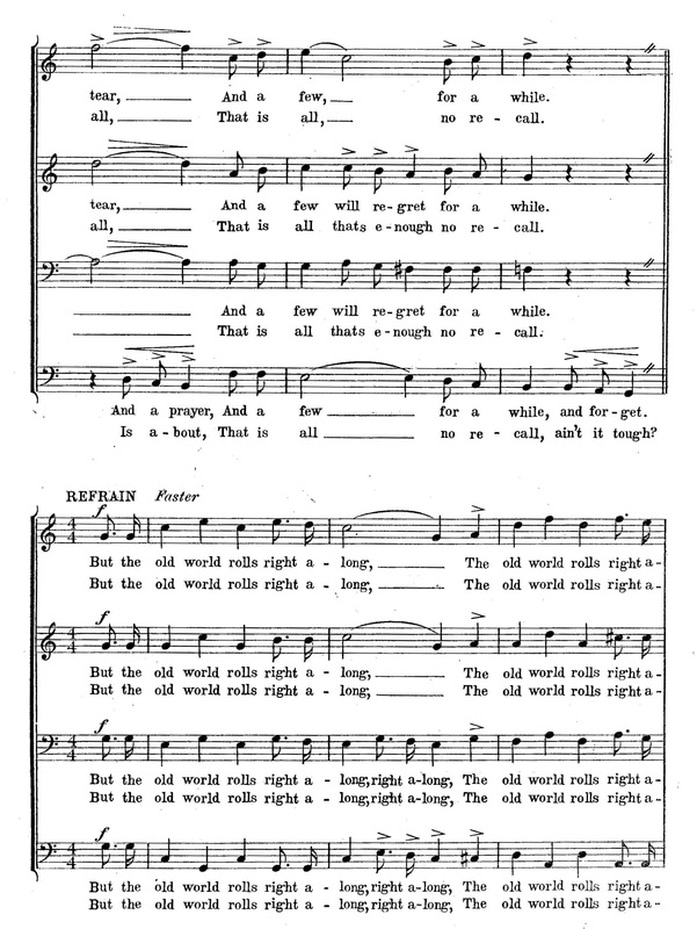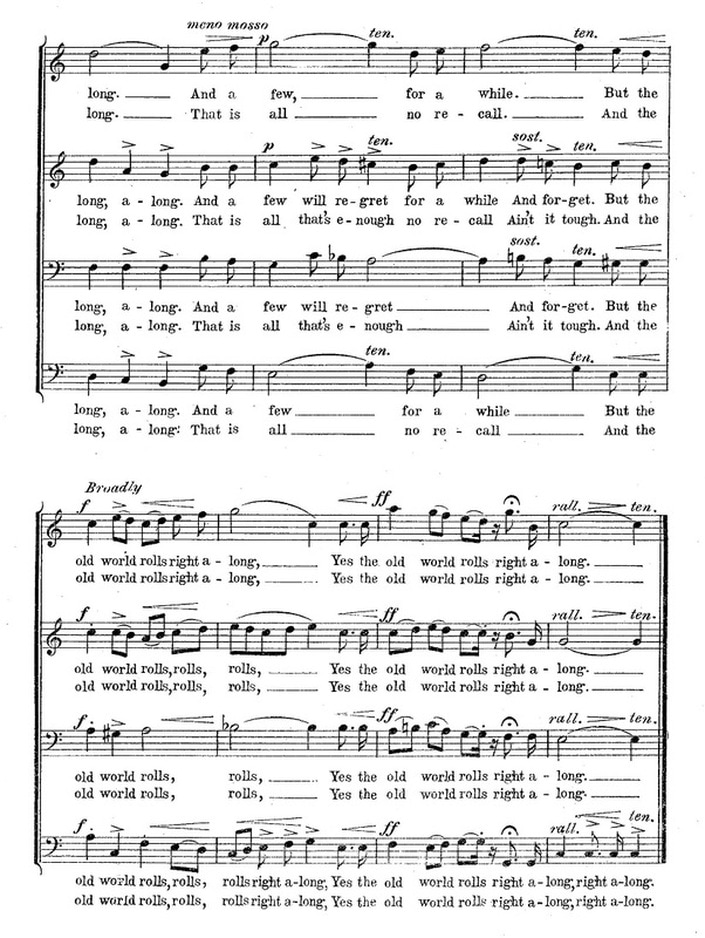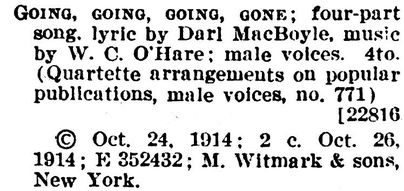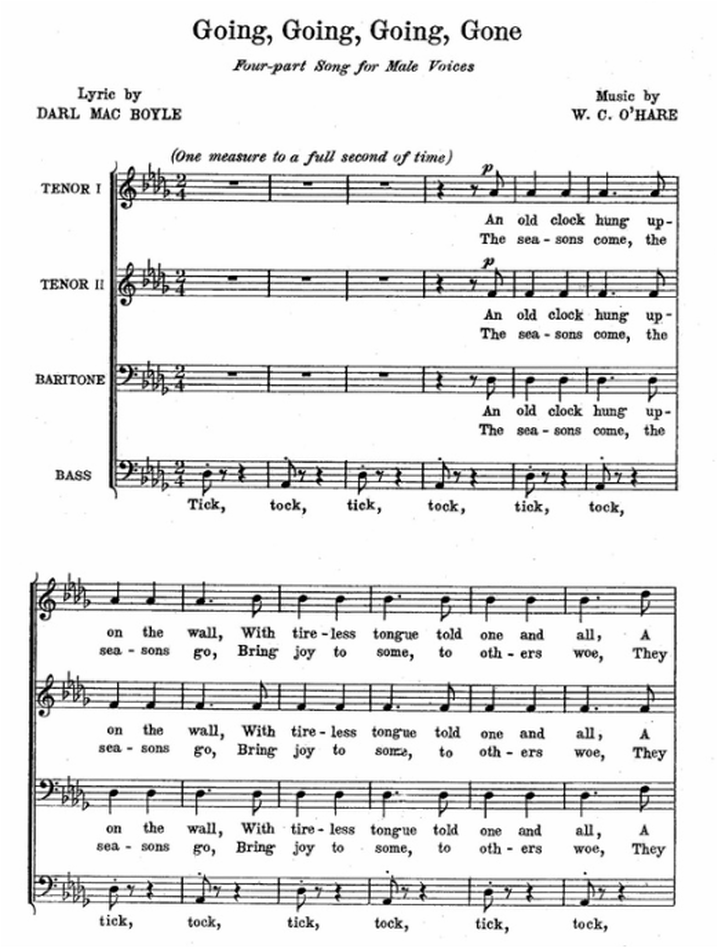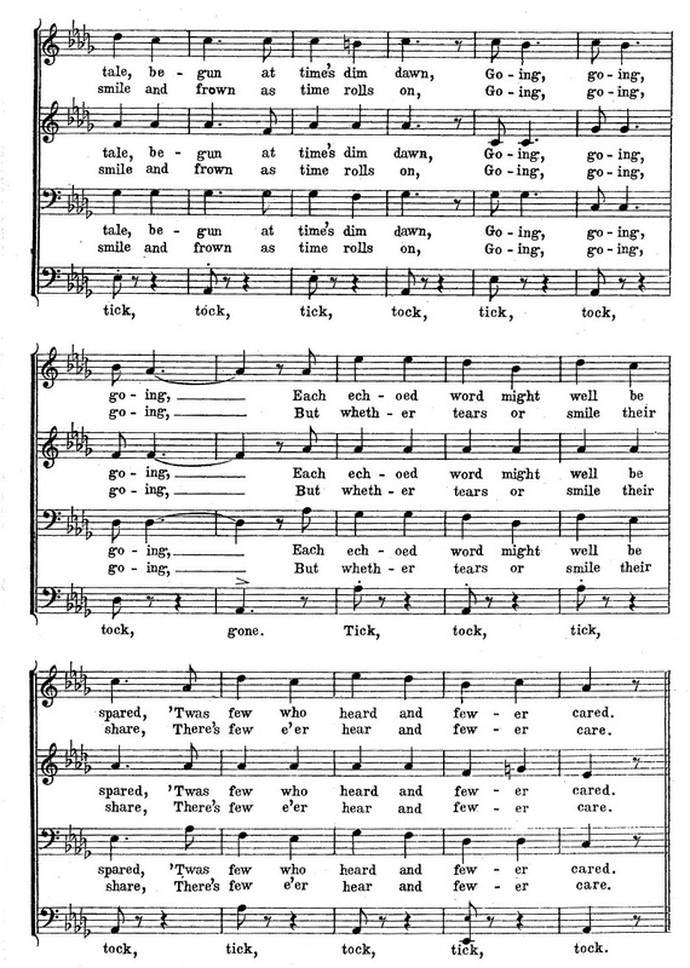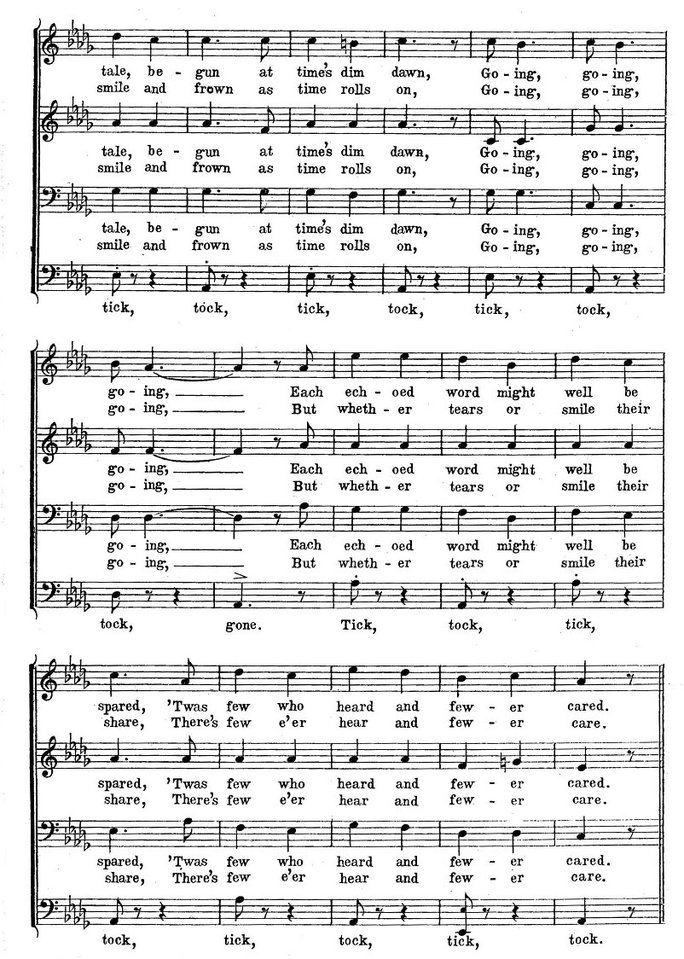O'Hare's First Published Four-Part Compositions (Witmark, 1905)
The year before Witmark published O'Hare's first four-part voice arrangements of songs written by several of Witmark's popular composers, the firm issued a few of his own songs, beginning with its Standard Quartettes series.
The Monkey Quartette (Witmark, 1905)
|
First to appear was The Monkey Quartette--a humorous paraphrase of The Monkey's Wedding, a folk or minstrel nonsense song that had been around since sometime before 1842 when "Master Henry, the infant prodigy, only 7 years of age" sang it at the Brooklyn Lyceum. In March 1868, the Arlington Minstrels, managed by J. H. Haverly, were singing The Monkey's Wedding. In mid-October 1875, the Queen's Minstrels' were performing it in Australia. In June 1882, Haverly's Consolidated Mastodon Minstrels were singing it.
|
Although lyrics vary slightly from source to source, this 1879 newspaper item illustrates what former minstrel O'Hare may have known for many years:
O'Hare' did not arrange The Monkey's Wedding's lyric for four voices, renaming it The Monkey Quartette. Instead, he had his fun with a portion of verse 1, focusing on the monkey's kiss and omitting the baboon's sister's yell in the church. By ignoring part of the original opening verse and all of the subsequent verses, he makes a nonsense song even more nonsensical.
Tenor I soon joins bass to emphasize the ludicrous intensity of the simian kiss. With quick repetitions of the action and the switch from quarter notes to half notes on "sis-ter" in measures 7-8, O'Hare further stresses the silliness inherent in the situation. Making a new comic song out of almost nothing, O'Hare repeatedly exclaims, "O what bliss!" (measures 9, 10, 11-12), sometimes with a slowed tempo on "bliss."
O'Hare further enhances the humor by his use of dynamic and parenthetical performance indicators. The soft volume of "O lovely Baboon," sung :with feeling," may give credit to the bride's beauty, but it contrasts sharply with the much louder closing "Monk" section, sung "with exhilaration." Throughout the final seven measures, O'Hare uses rests, accents, dynamics indicators, slurs, ties, and holds to stress the Monk's macho conquest. The result is a ridiculous, almost mock-epic, extolling of the quartet's new hero, now more important than his bride in the earlier folk/minstrel song.
O'Hare further enhances the humor by his use of dynamic and parenthetical performance indicators. The soft volume of "O lovely Baboon," sung :with feeling," may give credit to the bride's beauty, but it contrasts sharply with the much louder closing "Monk" section, sung "with exhilaration." Throughout the final seven measures, O'Hare uses rests, accents, dynamics indicators, slurs, ties, and holds to stress the Monk's macho conquest. The result is a ridiculous, almost mock-epic, extolling of the quartet's new hero, now more important than his bride in the earlier folk/minstrel song.
When O'Hare paraphrased The Monkey's Wedding, many older people would have recalled the song from its minstrel days. With newspapers occasionally reprinting the old lyric during the opening years of the 20th Century, we can guess that it was well known during the years immediately leading up to O'Hare's paraphrase.
Love's Four Seasons (Witmark, 1905)
|
Copyrighted on November 11 with lyrics by George Taggart and music by O'Hare, the four-part song cycle--Love's Four Seasons--opens with the birth of love amid the nesting robins, blooming daffodils, and soft breezes and closes with the death of love as winter "kills the frail," wrapping it in a "shroud of white" and further concealing it beneath the winter sky's gray "vault of the grave."
O'Hare appropriately opens Spring in the highest voice with the lowest voice's extended "Ah!" emphasizing the pleasure of spring in verse 1 and of young love in verse 2. Tenor II opens the chorus as the other voices joyfully sing "La la," eventually joining in to declare that "Nature's songs . . . are born of love." |
In contrast, O'Hare opens Winter in the lowest voice with others soon introducing laughter as if to say that the song depicts nature's cruel trick on lovers This laughter stops with the sky's "vault of the grave." Leading up to the final exclamation, O'Hare indicates that Baritone should dramatize the wild wind's sad song by voicing it in a "quasi chant." Each time O'Hare ends the chorus, he increases the dynamics, first instructing ff and then fff on the closing exclamation: "And love is the first to die!"
The Standard Quartettes series also included O'Hare's Farewell Welsh Rarebit, the quartet arrangement of the song copyrighted three months earlier with words by Frank Sheridan and music by O'Hare.
Excellent Quartette Arrangements
|
Don't Shove (1905)
Don't Shove appears to have been a humorous imitation of a traditional shout for which O'Hare composed the music and arranged it for four-part male voices.
William Devere had written at least one book of narrative poems in Western vernacular, John Marshall's New Pianner and other Western Stories, published by Witmark in 1897. In early 1904, he became ill, and he died in April, nearly a year and a half before Witmark copyrighted Devere's lyric and O'Hare's music/vocal arrangement for Don't Shove.
|
Devere's shout lyric intermingles traditional ideas and phrases from spirituals with modern elements. Like many spirituals, Don't Shove offers advice for reaching heaven, talking of the goal as a journey. Verse 1 opens with "O if you're in a hurry for the great las' day, Don't shove, Don't shove!" According to the shout, the journey is made, at least in part, by climbing until one reaches St. Peter, who holds the keys to glory. One is reminded of spirituals such as We Are Climbing Jacob's Ladder and Climb Up, Ye Little Children.
Yet these traditional religious elements are interrupted by humorous advice such as "Git ready for the journey and put up a little snack." Musically, O'Hare assigns segments of both verses to individual voices, having everyone join on "Don't shove."
Verse 2 draws on the spiritual Keep A-Inchin' Along, which advocates slow and steady progress. The verse opens with a warning to heaven-seekers: "Dar'll be a lot of trouble if you go too strong, Don't shove! So jes' take it easy, keep a-inch'n' along . . . . . . . . . Don't shove! Dar's some will keep a shovin' an' treadin' on feet."
Devere introduces humor as he adds, "Jes' think they're kinder sassy an' dey never can be beat. Don't fret or worry, you are bound to get a seat. " He again might make listeners chuckle a few measures later as Tenor 1 sings, "You're welcome sinner . . . . . . . . . An' you're bound to be a winner." O'Hare enhances the humor of sinner- turned-winner by repetition of "sinner" in the other voices and their "Yes" as Tenor I holds "winner."
In 1913, O'Hare arranged Don't Shove for female voices, presumably indicating vocal groups' continued interest in the song.
Yet these traditional religious elements are interrupted by humorous advice such as "Git ready for the journey and put up a little snack." Musically, O'Hare assigns segments of both verses to individual voices, having everyone join on "Don't shove."
Verse 2 draws on the spiritual Keep A-Inchin' Along, which advocates slow and steady progress. The verse opens with a warning to heaven-seekers: "Dar'll be a lot of trouble if you go too strong, Don't shove! So jes' take it easy, keep a-inch'n' along . . . . . . . . . Don't shove! Dar's some will keep a shovin' an' treadin' on feet."
Devere introduces humor as he adds, "Jes' think they're kinder sassy an' dey never can be beat. Don't fret or worry, you are bound to get a seat. " He again might make listeners chuckle a few measures later as Tenor 1 sings, "You're welcome sinner . . . . . . . . . An' you're bound to be a winner." O'Hare enhances the humor of sinner- turned-winner by repetition of "sinner" in the other voices and their "Yes" as Tenor I holds "winner."
In 1913, O'Hare arranged Don't Shove for female voices, presumably indicating vocal groups' continued interest in the song.
A Pair of Vocal Scores Demonstrating O'Hare's Versatility (1914)
In 1914, O'Hare faced what might have been a challenge as a composer and arranger for Witmark's Excellent Quartette Arrangements series. Darl MacBoyle had composed lyrics for two songs on the same topic--human mortality in an indifferent world. With the task of composing the music for both lyrics and arranging the songs for male voices, O'Hare may have felt pressured to distinguish them sufficiently from one another--to imbue each with its own sound and character. Perhaps taking his cue from the song titles and the appearance of title words within the lyrics, he overcame the challenge.
In And the Old World Rolls Right Along, O’Hare varies traditional call and response structure, something he would have known well from his interest in black music. Rather than assigning one or two voices to introduce a thought and having others respond, he uses all or most of the voices to introduce the thought, and one or more to repeat, to elaborate, or to offer a contrasting thought.
Throughout the refrain, O’Hare provides performance guides to bring out the song’s bleak message. For example, as the refrain opens, he notes that singers should increase the dynamics and the tempo, thus underscoring the earth’s unceasing motion. As phrases from the verses are reintroduced in the refrain, he indicates a softening and slowing. By including other performance guides such as a brief rest before and a fermata on the penultimate "right," O’Hare reminds listeners of the contrast between the earth's ceaseless, indifferent movement and its residents' mortality. The closing Bass reiteration of “right a-long,” gradually louder and accented, prolongs that emphasis and intensifies that indifference. It’s impossible to know if MacBoyle wrote out the words for the refrain or if they were O’Hare’s doing when preparing a simple lyric for performance. Whatever the case, O’Hare, as composer and vocal arranger, dramatically drives home the lyric’s message in the song’s final moments.
A quick glance at the second MacBoyle-O'Hare song in the pair reveals O'Hare's instruction: "One measure to a full second of time." O'Hare is marking the passing time with the mechanical tick-tock of a clock, gradually counting down the years in a lifetime.
For the first two-thirds of the song, Tenor I, Tenor II, and Baritone simultaneously sing the same words. The frequent voice changes that characterized And the Old World Rolls Right Along are conspicuously absent. Less frequent, too, are the many tempo and dynamics indicators found in the song from only two months earlier.
For the first two-thirds of the song, Tenor I, Tenor II, and Baritone simultaneously sing the same words. The frequent voice changes that characterized And the Old World Rolls Right Along are conspicuously absent. Less frequent, too, are the many tempo and dynamics indicators found in the song from only two months earlier.
Staccato eighth notes used for the tick-tocks contrast with the quarter notes and occasional dotted quarter notes most commonly sung by Tenors I and II and Baritone. Only when the other voices sing "go-ing, go-ing, go-ing" does Bass stop marking time and, instead, indicate the end of a life.
On the refrain, O'Hare assigns Baritone a slow, fateful tolling, each "Dong" beginning loudly and gradually diminishing over four measures, mimicking the sound of a church bell. The last "Dong" fades on the final "gone." Someone has died, but O'Hare indicates that the tireless clock will continue its mechanized tick-tocks, and the survivors will live on heedless of passing time that will also end their lives.
On the refrain, O'Hare assigns Baritone a slow, fateful tolling, each "Dong" beginning loudly and gradually diminishing over four measures, mimicking the sound of a church bell. The last "Dong" fades on the final "gone." Someone has died, but O'Hare indicates that the tireless clock will continue its mechanized tick-tocks, and the survivors will live on heedless of passing time that will also end their lives.
Background image, top of page: detail from a Witmark quartet collection cover

